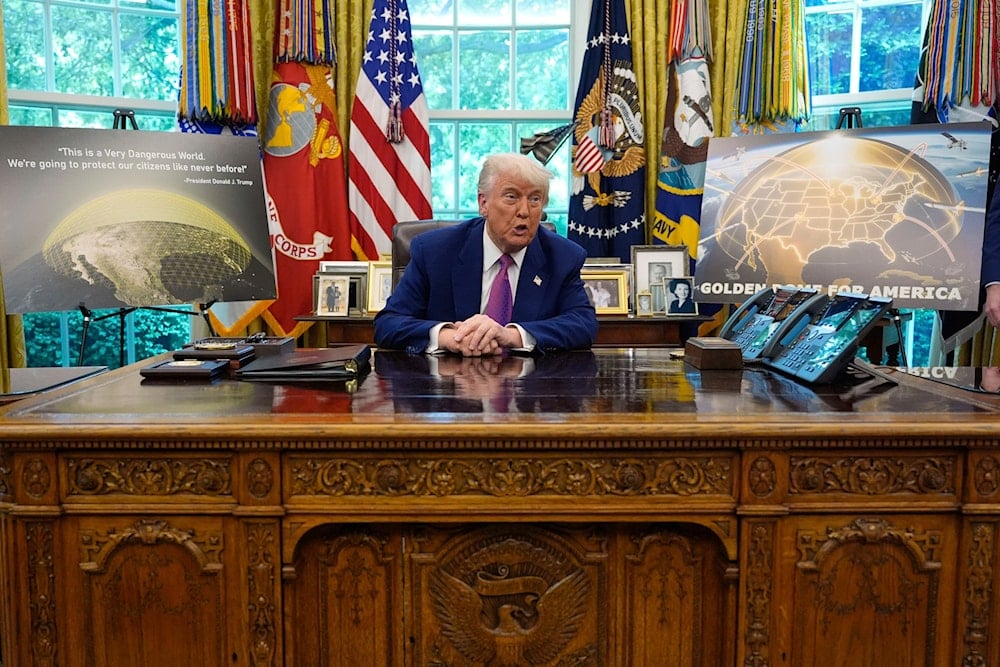Golden Dome missile defense won’t be done before Trump’s term ends
Donald Trump's Golden Dome missile defense program aims to establish a space-based missile interception system, but Pentagon plans show full capability may not be achieved before 2028.
-

President Donald Trump speaks in the Oval Office of the White House, Tuesday, May20, 2025, in Washington. (AP)
US President Donald Trump’s Golden Dome missile defense program, which will include space-based weapons designed to intercept strikes against the US, is unlikely to be completed before the end of his term, even though he has claimed it would be finished within the next three years, The Guardian reported on Saturday.
Last week in the Oval Office, Trump announced that the US Space Force, led by Gen. Michael Guetlein, would oversee the Golden Dome project, expressing confidence it would be "fully operational" before he leaves office.
However, according to a Pentagon implementation plan described by two sources, the defense weapons are only expected to be ready for a demonstration under ideal conditions by the end of 2028.
The Golden Dome program is being rolled out in phases rather than becoming fully operational at once, with the Pentagon first prioritizing the integration of data systems before moving on to the development of space-based weapons, according to the sources.
Within 18 months, the US could potentially establish the foundational framework for a fully operational Golden Dome system, enabling a military network of satellites and space-based communication systems to monitor hundreds of incoming missiles targeting the US.
Space-based weapons not possible
At that stage, there would still be no ability to intercept missiles using space-based weapons, though the US could potentially utilize its approximately 40 Patriot defense batteries stationed in Alaska and California to target incoming intercontinental ballistic missiles.
By the time Trump's term concludes, the Pentagon may have established a network of space-based sensors and communications systems while attempting to integrate them with unproven space-based weapons for missile interception capabilities.
The space-based network is expected to depend significantly on Elon Musk’s SpaceX, which has been working on an advanced tracking system called the "aerial moving target identifier," with the Defense Department having obtained the initial prototypes last year under the Biden administration.
The flagship concept for Golden Dome, which aims to detect and destroy ballistic missiles within the first 30 seconds to two minutes after launch when their heat signature is strongest, a period known as the "boost phase," is not anticipated to be operational.
According to The Guardian's sources, the technology required for a space-launched counter-missile to penetrate Earth's atmosphere with sufficient force to destroy a ballistic missile remains under development and may not be viable for years.
Trump's ambitions face many hurdles
The Guardian reported that while a White House spokesperson declined to comment on the matter, Pentagon spokesperson Sean Parnell issued a statement asserting that the Defense Department "will not publicly disclose specific technical details regarding the capabilities or acquisition strategies of certain advanced systems."
According to two sources familiar with the matter, the Trump administration has estimated that the Golden Dome could cost approximately $175 billion, with this figure being based on Pentagon budget allocations of $17.6 billion for 2026, around $50 billion for 2027, and approximately $100 billion for 2028.
The final costs could be higher, depending on Trump's ambition: if the President wants the ability to intercept 100 ballistic missiles, it would necessitate the deployment of thousands of satellites that will need replacement every few years, a very costly endeavor.

 3 Min Read
3 Min Read










